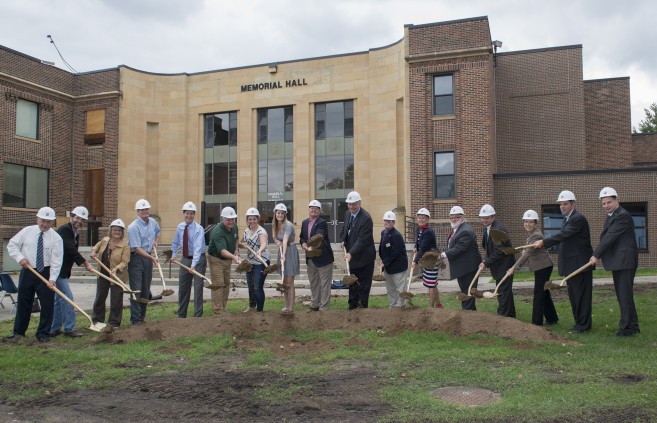
Bemidji State University formally broke ground on a nearly $14 million project to renovate Memorial Hall into a state-of-the-art new home for its business and accounting programs during an on-campus ceremony held in conjunction with the university’s ninth annual Community Appreciation Day.
“This project, when it’s completed, will have a significant impact on our current students and faculty and for future faculty and students,” Bill Maki, BSU’s vice president for finance and administration, said during the ceremony.
Built in 1940, Memorial Hall is the fifth-oldest permanent building on the BSU campus and has never received major renovation. Its historic front lobby will be retained, but the center of the building that is now a basketball court with built-in bleachers on two sides will be converted into classroom space. The classrooms will be focused on small-group activities, with flexible small-group workspaces in each of the building’s hallways.
“While we may see some remnants of a gymnasium floor when we walk in, the basketball court and the bleachers will become classrooms,” said Shawn Strong, dean of BSU’s College of Business, Technology and Communication. “But they won’t be the classrooms that maybe we’ve been accustomed to. Throughout the building, there will be flexible space that will encourage small-group learning and active problem-solving, assisted by our latest technology.”
The Memorial Hall renovation is the keystone in a broader construction project that will radically alter the heart of campus as part of a strategic effort to centralize academic offerings and shift student services to a part of campus that better suits BSU’s resident students.
“The building represents the affirmation of the vision of academic excellence,” BSU President Richard A. Hanson said. “It’s going to be an excellent facility with state-of-the-art classrooms and aunique learning environment. It’ll be one of the more important buildings on campus.”
Maki said the new Memorial Hall will be BSU’s first LEED-certified building and include a variety of energy and conservation techniques that will continue the university’s efforts to reduce its carbon footprint.
